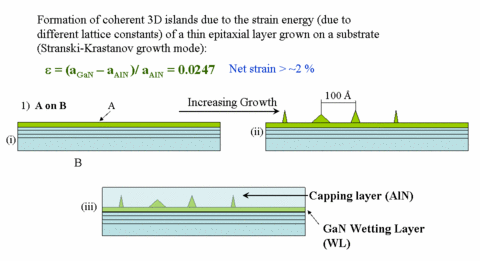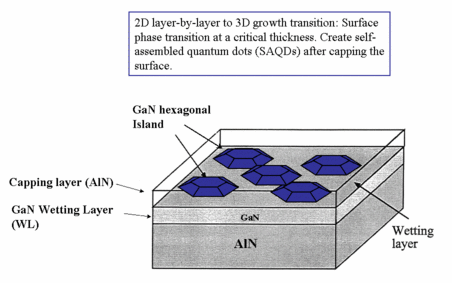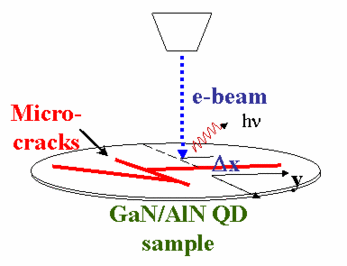Time-Resolved Cathodoluminescence Studies of Semiconductor Quantum Dots Grown On Silicon Substrates
Daniel Rich
We study the optical properties of vertically stacked GaN/AlN self-assembled quantum dots (SAQDs) grown on Si substrates. We use temporally and spatially resolved cathodoluminescence (CL). CL is generated by the injection of a tunable and position-controllable high-energy electron beam from a scanning electron microscope (SEM) into a semiconductor sample. The electron beam generates a large density of electron-hole pairs, many of which recombine radiatively across the bandgap of the semiconductor, thereby generating the luminescence which is subsequently detected and analyzed. Potential applications of these quantum dots include light source for UV-blue-green LEDs, lasers, optical information storage, single photon emitters and sources of entangled photons (quantum information technology).
While the presence of thermal stress-induced micro-cracks is clearly undesirable when attempting to obtain high-quality thin film growth of III-Nitride films and SAQDs on Si substrates, the presence of micro-cracking however enables a study of interesting stress-induced energy shifts and lifetime changes in the QD optical transitions that can be measured with a high-resolution spatially resolved probe, such as with CL. Normally, it is difficult to locally perturb the strain tensor of QDs in a reliable and reproducible way with an external stress. We have found such a way using the micro-cracks as stressors in our research. Three-dimensional 6*6 \vec k \cdot \vec p calculations of the QD electron and hole wave functions and eigenstates were performed to examine the influence of biaxial and uniaxial stresses on the optical properties in varying proximity to the micro-cracks.
 |
 |
|
| Figure 1: Growth process of Self Assembled Quantum Dots (SAQD) in the Stranski-Krastanov growth mode. Click to enlarge. | Figure 2: Schematic showing the structure of SAQD sample. Click to enlarge. | |
 |
||
| Figure 3: Schematic explaining the CL experimental method used in studying the effects of the micro-cracks. | ||